





Introduction
Fighters by Nature
Betta Behaviour
Carding of Bettas
Purchasing Your Betta
Personal Experience
My Bettas
FAQs
Recommended Reading
Acknowledgement
Related Links
Welcome to Daniel Chia's Betta Barracks. This site attempts to offer some information and tips on the selection, care and maintenance of the Betta splendens or Siamese fighting fish, as well as to provide answers to a few frequently asked questions.
Bettas can be fascinating, enjoyable and educational pets if they are provided with a suitable living environment and given the proper routine care. It is hoped that the content offered here will be useful to those who wish to pursue betta keeping as an interest.
The Betta splendens or Siamese fighting fish which is native to Thailand (formerly Siam) and Cambodia (formerly Kampuchea), is a popular ornamental fish known for its pugnacious nature, a fact borne out by its name and the Thai culture of staged matches between these aquatic fighters.
"Records from the reign of King Lithai of Sukhothai allude to fighting fish being reared for sport."
- Thailand Illustrated (2001), Vol. 18, No. 2
Despite having been kept in Thai households since the Sukhothai Period (1238-1438) and introduced to European aquarists in the 1800s, the legendary belligerent qualities of this fish remain as enthralling as ever.

Above:
Distribution of Betta splendens
(wild form only).
For centuries, hobbyists were attracted to the Betta splendens, primarily because of its fighting nature. In recent years, betta enthusiasts are able to enjoy a higher level of aesthetic appreciation of this interesting fish because selective breeding has produced many varieties of bettas with brilliant colours and gorgeous caudal (tail) forms. While the strikingly beautiful betta familiar to today's hobbyists bears little resemblance to the drab-coloured, short-finned wild form, its territorial and aggressive behaviour remains very much the same.

Above: Betta
splendens featured on Thai postage stamps.
When a male betta (or in some instances a female) sees another, its immediate response will be one of intimidation. It will react by stretching out its fins and opening its opercula (gill covers), trying to add extra dimensions to make itself look bigger and meaner; very much like a peacock showing off. At the same time, the fish's chromatophores (pigment cells) will expand and the betta's colour will intensify. If the rival reciprocates with the same threatening poise, the two fish will attack each other, inflicting damage to the opponent by biting the fins, jaw or body. This is why bettas need to be kept separated in individual tanks or jars.
Above: Opercula
of betta at rest
(left) and when flaring (right).
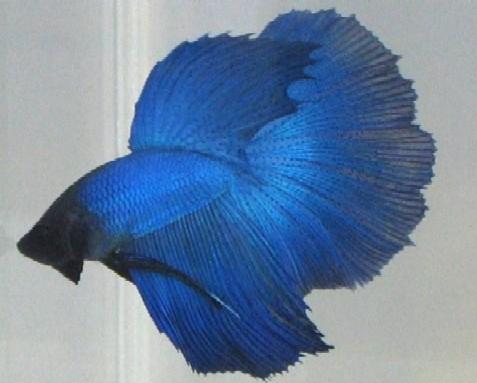
Above: A betta in
full flare is a truly magnificent sight.
Place opaque cardboard or plastic cards between your bettas' tanks or jars. When the cards are removed, the bettas will flare or display at each other. Do remember to keep the cards in place after each flaring session. Otherwise, the bettas will get used to one another and stop displaying. Prolonged flaring or displaying may also result in fin damage, especially in half-moon and super delta tail bettas.
Above: Carded bettas
are happy bettas.
According to Walt Maurus, author of Bettas: A Complete Introduction,
"The fins of the betta are only a few cells thick, so tears in the fins from activity can be likened to the fraying of the edges of a flag flapping in the wind."
So, do be mindful that the fins of your betta can become ragged if it is subjected to vigorous activity like prolonged flaring or displaying.
Bettas in retail stores are usually housed in individual tanks, jars, bottles or in divided compartments within an aquarium. When selecting bettas, take time to observe their behaviour and look for signs of illness. If the fish is inactive, instead of swimming about and flaring when placed next to others, they may be poorly cared for, potentially ill or carrying diseases.
Above: Plakats
(short tail bettas) in whisky bottles at a store.
Dr Robert Goldstein, author of Bettas: A Complete Pet Owner's Manual, advises:
"A healthy fish should have clear eyes, unsplit fins, no bite marks, and no white rims or margins on the fins or body. The body should be full but not bloated, and thick; avoid fish that appear sunken or showing their ribs. Discrete fecal droppings should litter the bottom of the jar indicating regular feeding and normal digestion. Females should be almost obese yet active, with a prominent white egg-spot at the vent (the end of the oviduct), and should swim without struggling to maintain equilibrium."
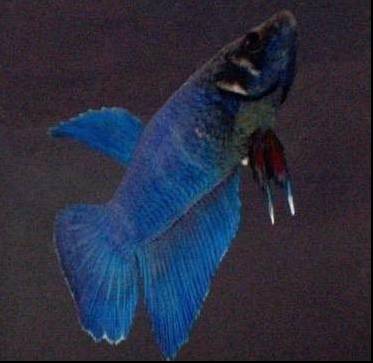
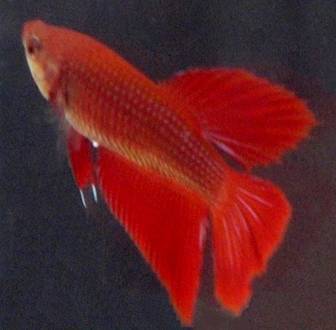
Above: The white egg-spot (ovipositor) protrudes from
the female's abdomen.
In Singapore, there are several sources of fancy bettas. If you are looking for Singaporean farm-bred competition grade bettas and giant plakats, you will be thoroughly amazed by the impressive range bred by Mr Yeo Eng Meng and Ms Diana Yang when you step into Straits Aquariums. This fish farm is the cradle of top notch aquarium fishes (including show quality bettas), an International Betta Congress (IBC) member, a Betta Club Singapore (BCS) commercial member and the recipient of numerous national and international accolades. Do note that they accept only cash and there are no ATMs in the vicinity of Straits Aquariums. So, don't forget the money.
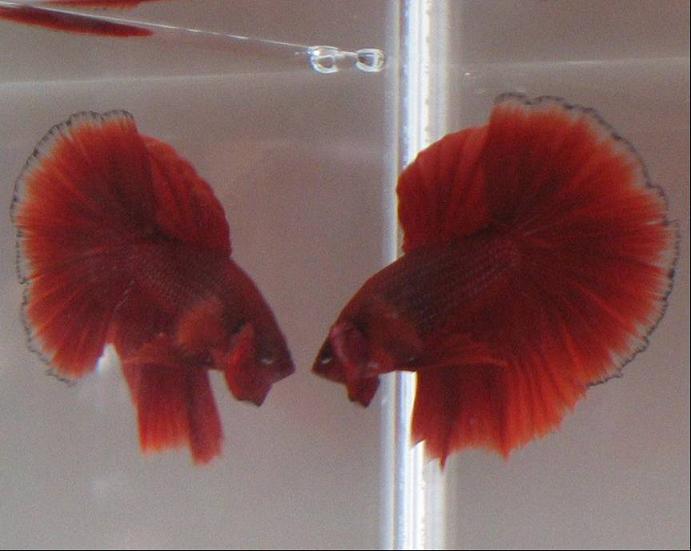
Above:
A Singaporean farm-bred half-moon purchased from Straits Aquariums.
Another good source is Kelson Betta, a commercial member of Betta Club Singapore (BCS) and an International Betta Congress (IBC) member. This betta specialty shop is operated by Mr Kelson Say, an award-winning breeder who breeds and imports show quality half-moons, crown tails, double tails and plakats. Kelson Betta is also the place to go to if you are looking for books and posters on bettas, as well as medications, tanks and other essential items for betta keeping.

Above:
Half-moon plakats acquired from Kelson Betta.
You will also be able to find fancy bettas at the betta sections of Betta House Aquariums & Pet Centre and Aqua Star Trading. The latter is an impressive one-stop shop where you will find both marine and tropical fish, as well as a wide selection of fish tanks, fish foods, fish medications and other necessities.
Before a trip to any of the mentioned sources, it is advisable to make a telephone call to check their operating hours and to make an appointment.
I find bettas robust and relatively easy to care for. I used to breed them but have since halted my betta production because of other commitments. My short tail bettas (e.g. plakats and females) are housed in 4x4x8 inch acrylic tanks while my fancy tail bettas (e.g. crown tails and half moons) are transferred to 6x6x8 inch acrylic tanks when their caudals are fully grown. I feed my bettas either freeze-dried bloodworms (Chironomids) or Hikari Betta Bio-Gold pellets twice a day. Occasionally, they are fed live brine shrimps (Artemia salina) or Sea-Monkeys (vitaminized with Aqumedi MultiVit) for variety. A common problem with the frequent feeding of dried foods (e.g. freeze-dried bloodworms and pellets) is constipation. Bettas can be fed green peas (cooked, de-shelled and cut into bite-size portions) to prevent or treat this problem. Do ensure that dried foods are properly stored to prevent them from turning mouldy.
When they are accustomed to the feeding routine, some bettas may get excited and attempt to leap out of the water during feeding time. My short tail bettas tend to be quite good at this. To prevent mishaps, I keep the water surface at least 5 centimetres (2 inches) from the top of the tank.
Any uneaten food is removed after 3 minutes and I use a 10 millilitre plastic pipette as a 'Poop-Sucker' to clean the bottom of each tank at least twice a day. This is necessary to prevent the build-up of ammonia and urea. The 'Poop-Sucker', which comes in the "AZOO Palm Aquarium Cleaning Package", is manufactured in Taiwan by Taikong Corp and can be purchased from Aqua Star Trading.
I perform a partial (50 percent) water change at least twice weekly, on weekdays with aged water (1-day old) that has been treated with Stress Coat or Armour Coat (water conditioner to remove the chlorine and chloramine) and methylene blue (as a prophylaxis) or dried ketapang or Indian almond (Terminalia catappa) leaves (a more natural alternative, which is now available in the form of 'teabags'). A total (100 percent) water change is done once a week, on weekends. By then, the tanks do get a little slimy and they will need to be thoroughly washed. Such frequent partial and total water changes will need to be done manually unless one invests in a betta barracks drip system like those in the fish room of BC Betta.
When performing a total water change, I use the 'Betta Scoop' to transfer my bettas. The scoop, which is hand-crafted in Thailand and widely used there, allows the fish to be transferred in the comfort of their own old water. This useful piece of equipment can be purchased from Kelson Betta.
Above: Kids like Daryl (age 5) and Lydia
(age 3) can be taught to care for bettas.
With adequate nutrition, the right water condition and a careful maintenance schedule, disease can be prevented and bettas can live up to 2 to 3 years of age. They will be a special part of the family because everyone (especially the kids) will soon discover the fascinating nature of the fish and want to learn to care for them.
The following are a few thumbnails of photographs taken of my betta barracks, spawning tank and bettas (past and present).
My Betta Barracks
& Spawning Tank


Q1: What are the parts of a betta?
A1: The anatomy of the Betta splendens is illustrated in the following diagrams.

Above: Surface anatomy of the Betta
splendens.
Below: Internal anatomy of the Betta
splendens.
Q2: Why do bettas fight?
A2: Behavioural scientists are also interested to know why bettas are so aggressive. I believe they can't help it because they are made to behave this way.
Q3: Is it okay to fight bettas in Singapore?
A3: Under Section 42 (Cruelty to Animals) of the Animals and Birds Act (Chapter 7 of the Singapore Statutes), any person who is found guilty of ill-treating or causing the fighting of any animal (including fish) shall be liable to a fine not exceeding SGD$10,000 or to imprisonment for a term not exceeding 12 months or to both.
Above:
It is cruel and illegal to fight bettas.
Q4: How do I make my betta flare if I only have 1?
A4: Use a mirror. Bettas do not recognise their own reflection and they will think that there is an intruder. Just don't forget to remove the mirror after a while.

Above: A betta being tricked with a
mirror.
Q5: Do bettas need air pumps?
A5: Air pumps are not required because bettas are Anabantoids, a group of fish whose peculiar feature is an extra respiratory organ (the labyrinth) which enables them to swallow air from the water surface and use its oxygen. This enables the fish to survive where dissolved oxygen levels are low.
Q6: Why is my betta spitting bubbles?
A6: Betta splendens are bubblenesters. The male betta blows saliva of bubbles at the water surface to build its bubblenest. During spawning, when the eggs have been expelled by the female betta, the male betta will pick up the eggs and spit them into the bubblenest. Thereafter, the male betta will guard the bubblenest and tend to the fry after the eggs hatch.

Above: A male betta under its bubblenest.
Q7: Why is my female betta displaying stripes on its flanks?
A7: Vertical stripes indicate a female betta's readiness to spawn. Horizontal stripes are a sign of stress.
Above: Vertical
(left) and horizontal (right) stripes on female bettas.
Q8: There is a tear in the fin of my betta. Will it heal?
A8: Treat with MelaFix (an all natural antibacterial remedy made from Melaleuca Tea Tree extract) by Aquarium Pharmaceuticals and keep the water clean. Depending on the extend of the fin damage, tissue regeneration may be rapid or it may take a week or so.
Q9: Why is there cottony growth on my betta and why are its mouth and fins rotting? Is there a cure?
A9: Cottony growth, mouth rot and fin rot are signs of fungal and bacterial infections that should be promptly treated. For effective treatment, I recommend PimaFix, an antifungal and antibacterial preparation made from the West Indian Bay Tree (Pimenta racemosa) by Aquarium Pharmaceuticals. It can be used synergistically with MelaFix for a more effective treatment against fish disease and to promote rapid healing. Myxazin (a broad spectrum bactericide and fungistat) by Waterlife Research Industries is another trusted remedy.
Q10: My betta is swimming sideways and having difficulty maintaining its buoyancy. What should I do?
A10: Sometimes, when a fish overeats or is constipated, its stomach swells beyond the normal size and compresses its swim bladder (a hydrostatic buoyancy organ). This condition, which is known as Swim Bladder Disorder (SBD), causes the fish to lose control of its buoyancy, as well as its ability to swim normally. A fish suffering from Swim Bladder Disorder (SBD) needs time for its digestive system to gradually process the food in the stomach to allow the pressure on the swim bladder to reduce. Treat this disorder by fasting your fish for 24 to 48 hours. After the period of fasting, a bite-size portion of a cooked and de-shelled green pea could be fed to the fish to purge its gastro-intestinal tract. If the fasting and green pea treatment do not solve the problem, it could be due to a ruptured or injured swim bladder or a bacterial infection.
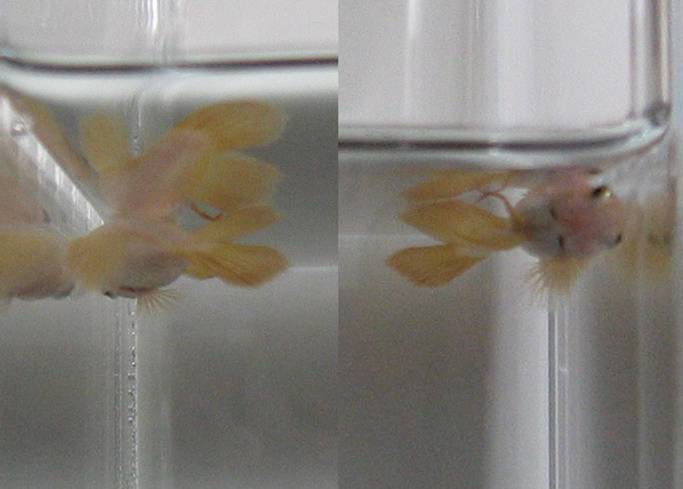
Above: A betta with
Swim Bladder Disorder (SBD).
Q11: The eyes of my betta look popped and are bulging. Is this normal?
A11: Bulging or popped eyes is a sign of internal bacterial infection. It is sometimes accompanied by a swollen abdomen with scales protruding outwards, giving the fish a pinecone-like appearance (a condition known as Dropsy). Internal bacterial infections are contagious, difficult to treat and can cause damage to the fish's central nervous system. Due care should be exercised to prevent cross infection (i.e. from one betta tank to another). Treat the fish promptly with Interpet Aquarium Treatment No. 9 - Anti Internal Bacteria, Ocean Free Super Internal Bacteria & Ulcer Away or Myxazin and hope for the best.
Q12: If I were to use a dropper to medicate my fish, how do I convert teaspoons and millilitres to drops?
A12: 1 teaspoon is 5 millilitres or 100 drops. If the recommended dosage were to be 1 teaspoon for every 10 gallons (40 litres) of water, 1 gallon (4 litres) of water would require 10 drops of the medication.
Above: A dropper.
Q13: What should I do if I'm going away for the weekend?
A13: Weekend or holiday food blocks should do the trick. Do remember to perform a final water change and quick 'poop-suck' before you go.
Q14: Where can I interact with betta hobbyists and get my questions about bettas answered?
A14: Join the Betta Club Singapore (BCS) Forum for free and post your questions there. I am sure the betta lovers there would answer your queries to the best of their ability.

Above: The Betta Club Singapore (BCS)
Forum.
Much of what I know about bettas comes from these few wonderful books, which I would recommend to anyone who wishes to learn more about this fish.
Bettas: A Complete Pet Owner's Manual
(below, left) by Dr Robert
Goldstein, is highly recommended. This wonderful
book has heaps of information about the various bubblenesting and mouthbrooding
betta species groups. It covers the selection of bettas, their housing (the 2001
edition has a chapter on Tanks for Bettas), feeding, breeding, genetics
(covering stuff like Betta Genes and the Punnet Square), as well as the
prevention, identification and treatment of common betta diseases (environmental, chemical and infectious). It is indeed a great source of
in-depth information about bettas and a complete pet owner's manual.
![]()
Bettas: A Complete Introduction
(below, centre) by Walt Maurus,
has some bits of information on basic betta care and it
provides plenty of advice on the breeding of bettas (environmental
conditions that encourage spawning and possible deviations that can occur during
the spawning process) and the raising of the fry (first foods, water
maintenance and jarring). It is recommended for those who are
interested in the challenge of going into the mass production and sale of bettas
for fun and for profit.
![]()
Labyrinth Fish: The Bubble Nest Builders (below, right) by Horst Linke,
is a very well written book that covers the identification, biotopes, general
care and breeding of both the bubblenesting as well as the mouthbrooding species
of the labyrinth fish in Asia and Africa. Horst Linke had done a lot of
research and packed this volume with heaps of good stuff, including photos of
more than 80 species of labyrinth fish (including over 30 betta species) and some very informative illustrations of these
special fish and their natural habitats. Highly recommended for the wild betta enthusiast who wants to differentiate the Betta coccina from the Betta
rutilans, or the Betta bellica from the Betta pugnax.
![]()
I would like to express my sincere gratitude to Mr Rick Ong whose heaps of helpful advice had been invaluable to me when I first attempted keeping and breeding bettas. Mr Ong was the proprietor of Betta Kingdom, a betta specialty shop which ceased its operations in late 2004. As a matter of fact, it was at Betta Kingdom that I met Mr Henry Yin, the well-known Indonesian breeder of award-winning crown tails. It had been an honour and privilege for me to be acquainted with these two gentlemen.
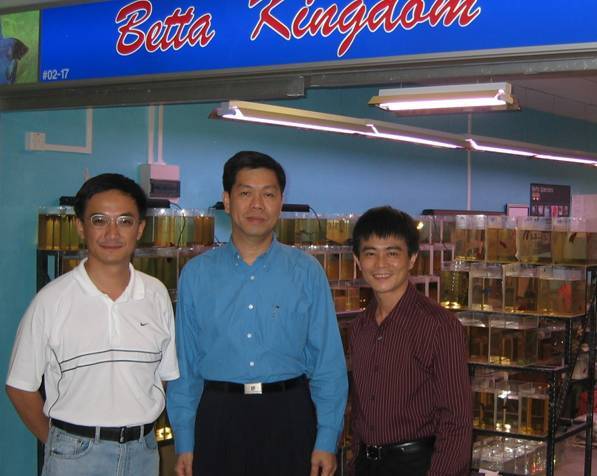
Above: At
Betta Kingdom with Mr Henry Yin (centre) and Mr Rick Ong (right).
These links provide useful information about bettas and are worth looking through. Please contact me if you have a site that you wish to recommend to Daniel Chia's Betta Barracks or if you would like your link removed.
"Colour
Strains of Betta splendens - The Siamese Fighting Fish" from That
Fish Shop
"Tail
Forms of Betta splendens - The Siamese Fighting Fish" from That Fish
Shop
"Betta splendens: General Information and Breeding" by Karl Baumgarten
"An Experiment to
Train a Betta to do a Trick" from Wayne's Betta Pages
"Betta
Movies" (Video clips of bettas spawning) by Kevin Pelletier
"Display Behaviors of Male Betta splendens" by Jennifer Beavin
Betty Splendens - Half Moon,
Double Tail and Crown Tail Bettas
"Rainbow-hued
bettas
have colorful history" by Bethany Keiper
Betta Territory - Quality
Betta splendens from the Netherlands
Betta Talk - The Ultimate Betta Site for
All Betta Lovers
"How to Entertain Your
Betta Fish" by Paul Toth
Atison Betta - Home of Show Quality
Bettas
International Betta Congress (IBC)
Cerulean Blue Betta
Awareness
Betta Club Singapore (BCS)
BETTAS by Jim Sonnier
BC Betta

God Bless Singapore
![]()
&
Peace on Earth

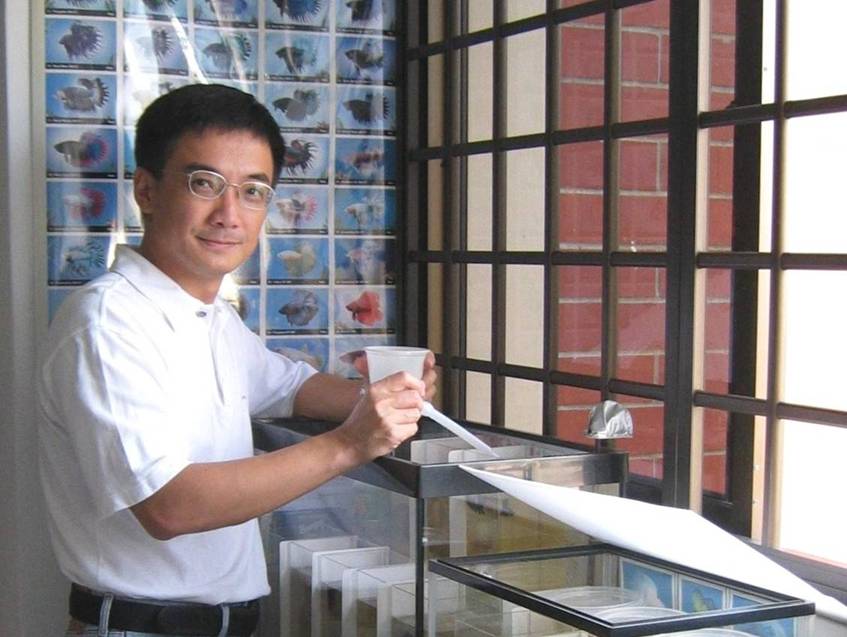
My email: [email protected]
Click
![]() to promote your website for
FREE.
to promote your website for
FREE.
Copyright ![]() 2004-2009
Daniel Chia Yee. All rights reserved.
2004-2009
Daniel Chia Yee. All rights reserved.